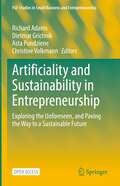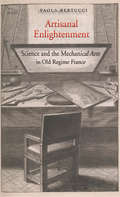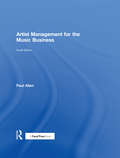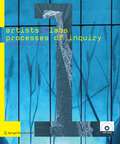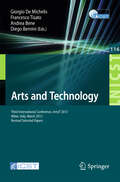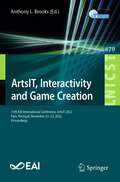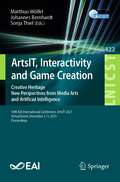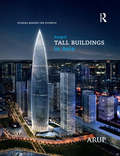- Table View
- List View
Artificial Riboswitches: Methods and Protocols (Methods in Molecular Biology #1111)
by Atsushi OgawaArtificial riboswitches and other ligand-responsive gene regulators make it possible to switch protein synthesis ON or OFF with arbitrary ligand molecules. Artificial Riboswitches: Methods and Protocols focuses on the state-of-the-art methods developed in recent years for creating artificial riboswitches, therefore this volume could be regarded as a collection of recipes for the gene circuit elements in synthetic biology and metabolic engineering. Chapters cover topics such as screening or rational design methods for obtaining artificial riboswitches that function in either bacterial or eukaryotic translational systems, protocols for evaluating the activities of the resultant riboswitches, as well as protocols for construction of ligand-dependent, trans-acting gene regulators. Written in the successful Methods in Molecular Biology series format, chapters include introductions to their respective topics, lists of the necessary materials and reagents, step-by-step, readily reproducible protocols, and notes on troubleshooting and avoiding known pitfalls.Authoritative and easily accessible, Artificial Riboswitches: Methods and Protocols seeks to serve not only bioengineers who aim to reprogram cell behaviors and molecular biologists who leverage these regulators for genetic studies, but to all researchers interested in this fascinating field.
Artificial Self-recovery and Autonomous Health of Machine
by Gao JinjiThis book explores the research fields of engineering cybernetics, bionics, artificial self-recovery and engineering self-recoveries. It explains the scientific and technological research results of artificial self-recovery, autonomous health technology and the application cases of assisted rehabilitation and autonomous health engineering. It provides guidance, latest research trends and development direction for researchers, scholars and engineers engaged in mechanical equipment fault diagnosis and autonomous health.
Artificial Sight: Basic Research, Biomedical Engineering, and Clinical Advances (Biological and Medical Physics, Biomedical Engineering)
by Mark S. Humayun Gerald Chader Elias Greenbaum James D. WeilandThis book describes advances in implantable neural stimulation technology to restore partial sight to people who are blind from retinal degnerative diseases such as age-related macular degeneration and retintis pigmentosa. Many scientific, engineering, and surgical challenges must be surmounted before widespread practical applications can be realized. The book summarizes the state of research and clinical practice in the field and reviews the current ideas and approaches of its leading researchers and practitioners.
Artificial Superintelligence: A Futuristic Approach
by Roman V. YampolskiyA day does not go by without a news article reporting some amazing breakthrough in artificial intelligence (AI). Many philosophers, futurists, and AI researchers have conjectured that human-level AI will be developed in the next 20 to 200 years. If these predictions are correct, it raises new and sinister issues related to our future in the age of
Artificial Superintelligence: A Futuristic Approach
by Roman V. YampolskiyA day does not go by without a news article reporting some amazing breakthrough in artificial intelligence (AI). Many philosophers, futurists, and AI researchers have conjectured that human-level AI will be developed in the next 20 to 200 years. If these predictions are correct, it raises new and sinister issues related to our future in the age of
Artificial Transmission Lines for RF and Microwave Applications (Wiley Series in Microwave and Optical Engineering)
by Ferran MartinThis book presents and discusses alternatives to ordinary transmission lines for the design and implementation of advanced RF/microwave components in planar technology.This book is devoted to the analysis, study and applications of artificial transmission lines mostly implemented by means of a host line conveniently modified (e.g., with modulation of transverse dimensions, with etched patterns in the metallic layers, etc.) or with reactive loading, in order to achieve novel device functionalities, superior performance, and/or reduced size. The author begins with an introductory chapter dedicated to the fundamentals of planar transmission lines. Chapter 2 is focused on artificial transmission lines based on periodic structures (including non-uniform transmission lines and reactively-loaded lines), and provides a comprehensive analysis of the coupled mode theory. Chapters 3 and 4 are dedicated to artificial transmission lines inspired by metamaterials, or based on metamaterial concepts. These chapters include the main practical implementations of such lines and their circuit models, and a wide overview of their RF/microwave applications (including passive and active circuits and antennas). Chapter 5 focuses on reconfigurable devices based on tunable artificial lines, and on non-linear transmission lines. The chapter also introduces several materials and components to achieve tuning, including diode varactors, RF-MEMS, ferroelectrics, and liquid crystals. Finally, Chapter 6 covers other advanced transmission lines and wave guiding structures, such as electroinductive-/magnetoinductive-wave lines, common-mode suppressed balanced lines, lattice-network artificial lines, and substrate integrated waveguides.Artificial Transmission Lines for RF and Microwave Applications provides an in-depth analysis and discussion of artificial transmission lines, including design guidelines that can be useful to researchers, engineers and students.
Artificial Transmission Lines for RF and Microwave Applications (Wiley Series in Microwave and Optical Engineering)
by Ferran MartinThis book presents and discusses alternatives to ordinary transmission lines for the design and implementation of advanced RF/microwave components in planar technology.This book is devoted to the analysis, study and applications of artificial transmission lines mostly implemented by means of a host line conveniently modified (e.g., with modulation of transverse dimensions, with etched patterns in the metallic layers, etc.) or with reactive loading, in order to achieve novel device functionalities, superior performance, and/or reduced size. The author begins with an introductory chapter dedicated to the fundamentals of planar transmission lines. Chapter 2 is focused on artificial transmission lines based on periodic structures (including non-uniform transmission lines and reactively-loaded lines), and provides a comprehensive analysis of the coupled mode theory. Chapters 3 and 4 are dedicated to artificial transmission lines inspired by metamaterials, or based on metamaterial concepts. These chapters include the main practical implementations of such lines and their circuit models, and a wide overview of their RF/microwave applications (including passive and active circuits and antennas). Chapter 5 focuses on reconfigurable devices based on tunable artificial lines, and on non-linear transmission lines. The chapter also introduces several materials and components to achieve tuning, including diode varactors, RF-MEMS, ferroelectrics, and liquid crystals. Finally, Chapter 6 covers other advanced transmission lines and wave guiding structures, such as electroinductive-/magnetoinductive-wave lines, common-mode suppressed balanced lines, lattice-network artificial lines, and substrate integrated waveguides.Artificial Transmission Lines for RF and Microwave Applications provides an in-depth analysis and discussion of artificial transmission lines, including design guidelines that can be useful to researchers, engineers and students.
Artificial Vision and Language Processing for Robotics: Create End-to-end Systems That Can Power Robots With Artificial Vision And Deep Learning Techniques
by Álvaro Morena Alberola Gonzalo Molina Gallego Unai Garay MaestreCreate end-to-end systems that can power robots with artificial vision and deep learning techniques
Artificiality and Sustainability in Entrepreneurship: Exploring the Unforeseen, and Paving the Way to a Sustainable Future (FGF Studies in Small Business and Entrepreneurship)
by Richard Adams Dietmar Grichnik Asta Pundziene Christine VolkmannThis open access edited volume explores the past, present, and future of artificiality and sustainability in entrepreneurship – the unforeseen consequences and ways to advance to a sustainable future. In particular, it connects artificiality, sustainability and entrepreneurship, intertwining artificial with the specific phenomenon of those novel digital technologies that provoke continuous and significant change in our lives and business. Unlike digital entrepreneurship research, which focuses on digital technology development and management, this book covers processes and mechanisms of sustainable adaptability of entrepreneurs, the business logic of start-ups, and the collaborative behaviours under the mass digital transformation, including the prevalence of artificial intelligence. Some of the questions that this book answers are as follows: How has entrepreneurship reacted to such challenges previously? What lessons have been learned and need to be carried forward? How can entrepreneurship and the artefacts of entrepreneurship respond to current challenges? What should be the mindset of the entrepreneur to assure sustainable adaptation? How to embrace and embed the new business logic?
Artificially Controllable Nanodevices Constructed by DNA Origami Technology: Photofunctionalization and Single-Molecule Analysis (Springer Theses)
by Yangyang YangIn this book, the author deals mainly with two topics: (1) single-molecule visualization of switching behaviors in the DNA nanoframe system utilizing different kinds of molecular switches through the use of high-speed atomic force microscope (AFM); (2) construction of photocontrollable DNA nanostructures in programmed patterns and direct visualization of the dynamic assembling process. Here, high-speed AFM was employed to observe the dynamic movements of single molecules. Compared to a traditional single-molecule analysis method, such as fluorescence spectroscopy or electron microscopy, high-speed AFM makes possible the real-time observation of molecule behaviors. DNA nanostructures were designed and assembled as scaffolds to incorporate interested biomolecules. The observations were carried out under robust conditions without complicated pretreatment. Moreover, the photoresponsive molecules were successfully assembled into around 100 nm-sized DNA nanostructures. The assembly/disassembly of nanostructures can be regulated reversibly by photoirradiation. This book explains how DNA origami has gradually become a useful tool for the investigation of biochemical interactions in defined nanospace. It also shows the possibility of DNA nanostructures acting as nanodevices for application in biological systems, serving as a good introduction to basic DNA nanotechnology.
Artificially Intelligent Nanomaterials for Environmental Engineering: For Environmental Engineering
by Peng Wang Jian Chang Lianbin ZhangPresents novel, nanotechnology-based solutions for urgent environmental engineering problems Clear and concise from beginning to end, this book focuses on the design and application of artificially intelligent nanomaterials, which help in solving many tangible environmental problems?especially water and air pollution. It lays out the design concepts, major chemical principles, and materials considerations of artificially intelligent nanomaterials for environmental engineering, and provides proof-of-concept examples such as improved filtration membranes, nanofibrous air filters, and molecularly imprinted nanomaterials. Artificially Intelligent Nanomaterials: For Environmental Engineering starts by describing the background of environmental nanotechnology, the rise of Artificial Intelligence (AI), and the current status of AI in environmental engineering. It then looks at: intelligently functional materials and responsive mechanisms; designing filtration membranes with responsive gates; switchable wettability materials for controllable oil/water separation; and self-healing materials for environmental applications. The book continues with chapters that examine: emerging nanofibrous air filters for PM2.5 removal; self-propelled nanomotors for environmental applications; molecular imprinting in wastewater treatment; and emerging synergistically multifunctional and all-in-one nanomaterials and nanodevices in advanced environmental applications. -Presents the state-of-the-art in environmental technology and puts forward bold ideas for its advancement -Addresses global challenges, including all important water and air quality which are critical for human health and a sustainable future -Concentrates on nanotechnology-enabled solutions for pollutant removal from water and air Artificially Intelligent Nanomaterials: For Environmental Engineering is an ideal book for undergraduates, graduates, scientists, and professionals in the fields of environmental science, material science, chemistry, and chemistry engineering.
Artificially Intelligent Nanomaterials for Environmental Engineering
by Peng Wang Jian Chang Lianbin ZhangPresents novel, nanotechnology-based solutions for urgent environmental engineering problems Clear and concise from beginning to end, this book focuses on the design and application of artificially intelligent nanomaterials, which help in solving many tangible environmental problems?especially water and air pollution. It lays out the design concepts, major chemical principles, and materials considerations of artificially intelligent nanomaterials for environmental engineering, and provides proof-of-concept examples such as improved filtration membranes, nanofibrous air filters, and molecularly imprinted nanomaterials. Artificially Intelligent Nanomaterials: For Environmental Engineering starts by describing the background of environmental nanotechnology, the rise of Artificial Intelligence (AI), and the current status of AI in environmental engineering. It then looks at: intelligently functional materials and responsive mechanisms; designing filtration membranes with responsive gates; switchable wettability materials for controllable oil/water separation; and self-healing materials for environmental applications. The book continues with chapters that examine: emerging nanofibrous air filters for PM2.5 removal; self-propelled nanomotors for environmental applications; molecular imprinting in wastewater treatment; and emerging synergistically multifunctional and all-in-one nanomaterials and nanodevices in advanced environmental applications. -Presents the state-of-the-art in environmental technology and puts forward bold ideas for its advancement -Addresses global challenges, including all important water and air quality which are critical for human health and a sustainable future -Concentrates on nanotechnology-enabled solutions for pollutant removal from water and air Artificially Intelligent Nanomaterials: For Environmental Engineering is an ideal book for undergraduates, graduates, scientists, and professionals in the fields of environmental science, material science, chemistry, and chemistry engineering.
Artillerie und Ballistik in Stichworten
by W. Oberst A. Busemann W. Eckardt O. Eggert W. Feucheter L. Hänert Ch. von Hofe K. Jutrow H.-H. Kritzinger A. Langhans H. Lüscher D.W. Marx W. Nehring K. Pannke V. SchläferDieser Buchtitel ist Teil des Digitalisierungsprojekts Springer Book Archives mit Publikationen, die seit den Anfängen des Verlags von 1842 erschienen sind. Der Verlag stellt mit diesem Archiv Quellen für die historische wie auch die disziplingeschichtliche Forschung zur Verfügung, die jeweils im historischen Kontext betrachtet werden müssen. Dieser Titel erschien in der Zeit vor 1945 und wird daher in seiner zeittypischen politisch-ideologischen Ausrichtung vom Verlag nicht beworben.
Artisanal Enlightenment: Science and the Mechanical Arts in Old Regime France
by Paola BertucciA groundbreaking work that places the mechanical arts and the world of making at the heart of the Enlightenment What would the Enlightenment look like from the perspective of artistes, the learned artisans with esprit, who presented themselves in contrast to philosophers, savants, and routine-bound craftsmen? Making a radical change of historical protagonists, Paola Bertucci places the mechanical arts and the world of making at the heart of the Enlightenment. At a time of great colonial, commercial, and imperial concerns, artistes planned encyclopedic projects and sought an official role in the administration of the French state. The Société des Arts, which they envisioned as a state institution that would foster France’s colonial and economic expansion, was the most ambitious expression of their collective aspirations. Artisanal Enlightenment provides the first in-depth study of the Société, and demonstrates its legacy in scientific programs, academies, and the making of Diderot and D’Alembert’s Encyclopédie. Through insightful analysis of textual, visual, and material sources, Bertucci provides a groundbreaking perspective on the politics of writing on the mechanical arts and the development of key Enlightenment concepts such as improvement, utility, and progress.
Artist Management for the Music Business
by Paul AllenAnyone managing an artist’s career needs to be well versed and have a savvy understanding of the moving parts of the music business. You’ll learn how and why those moving parts "move," as well as how to manage and navigate a music-based career. Artist Management for the Music Business gives you a comprehensive view of how to generate income through music and how to strategically plan for future growth. The book is full of valuable practical insights. It includes interviews and case studies with examples of real-world management issues and outcomes. Updates to this new edition include the importance of online streaming to music careers, how anyone can effectively network, tools for successful negotiation, ways to identify and manage income sources, and guidance on the ever-changing social media landscape of the music business. This book gives you access to resources about artist management and the music business at its companion website, http://www.artistmanagementonline.com. There is no login, and the resources are updated regularly.
Artist Management for the Music Business
by Paul AllenAnyone managing an artist’s career needs to be well versed and have a savvy understanding of the moving parts of the music business. You’ll learn how and why those moving parts "move," as well as how to manage and navigate a music-based career. Artist Management for the Music Business gives you a comprehensive view of how to generate income through music and how to strategically plan for future growth. The book is full of valuable practical insights. It includes interviews and case studies with examples of real-world management issues and outcomes. Updates to this new edition include the importance of online streaming to music careers, how anyone can effectively network, tools for successful negotiation, ways to identify and manage income sources, and guidance on the ever-changing social media landscape of the music business. This book gives you access to resources about artist management and the music business at its companion website, http://www.artistmanagementonline.com. There is no login, and the resources are updated regularly.
Artists-in-Labs: Processes Of Inquiry
by Jill ScottThis book verifies the need for the arts and the sciences to work together in order to develop more creative and conceptual approaches to innovation and presentation. By blending ethnographical case studies, scientific viewpoints and critical essays, the focus of this research inquiry is the lab context. For scientists, the lab context is one of the most important educational experiences. For contemporary artists, laboratories are inspiring spaces to investigate, share know-how transfer and search for new collaboration potentials. The nine labs represented in this book are from the natural, computing and engineering sciences. An enclosed comprehensive DVD documents the results, the problems and serves as a guideline for the future of true Art/Sci experiments.
Arts and Technology: Third International Conference, ArtsIT 2013, Milan, Bicocca, Italy, March 21-23, 2013, Revised Selected Papers (Lecture Notes of the Institute for Computer Sciences, Social Informatics and Telecommunications Engineering #116)
by Giorgio De Michelis Francesco Tisato Andrea Bene Diego BerniniThis book constitutes the thoroughly refereed proceedings of the Third International Conference on Arts and Technology, ArtsIT 2013, held in Milano, Bicocca, Italy, in March. The 19 revised full papers presented were carefully selected and reviewed from 31 submissions and are organized in topical sections on: art and technology in action, music and technology in action, reflecting on art and technology, understanding the artistic practice, and at the boundaries.
The Arts Management Handbook: New Directions for Students and Practitioners
by Constance DeVereaux Meg BrindleWhether the art form is theater, dance, music, festival, or the visual arts and galleries, the arts manager is the liaison between the artists and their audience. Bringing together the insights of educators and practitioners, this groundbreaker links the fields of management and organizational management with the ongoing evolution in arts management education. It especially focuses on the new directions in arts management as education and practice merge. It uses cases studies as both a pedagogical tool and an integrating device. Separate sections cover Performing and Visual Arts Management, Arts Management Education and Careers, and Arts Management: Government, Nonprofits, and Evaluation. The book also includes a chapter on grants and raising money in the arts.
The Arts Management Handbook: New Directions for Students and Practitioners
by Constance DeVereaux Meg BrindleWhether the art form is theater, dance, music, festival, or the visual arts and galleries, the arts manager is the liaison between the artists and their audience. Bringing together the insights of educators and practitioners, this groundbreaker links the fields of management and organizational management with the ongoing evolution in arts management education. It especially focuses on the new directions in arts management as education and practice merge. It uses cases studies as both a pedagogical tool and an integrating device. Separate sections cover Performing and Visual Arts Management, Arts Management Education and Careers, and Arts Management: Government, Nonprofits, and Evaluation. The book also includes a chapter on grants and raising money in the arts.
The Arts of the Microbial World: Fermentation Science in Twentieth-Century Japan (Synthesis)
by Victoria LeeThe first in-depth study of Japanese fermentation science in the twentieth century. The Arts of the Microbial World explores the significance of fermentation phenomena, both as life processes and as technologies, in Japanese scientific culture. Victoria Lee’s careful study documents how Japanese scientists and skilled workers sought to use the microbe’s natural processes to create new products, from soy-sauce mold starters to MSG, vitamins to statins. In traditional brewing houses as well as in the food, fine chemical, and pharmaceutical industries across Japan, they showcased their ability to deal with the enormous sensitivity and variety of the microbial world. Charting developments in fermentation science from the turn of the twentieth century, when Japan was an industrializing country on the periphery of the world economy, to 1980 when it had emerged as a global technological and economic power, Lee highlights the role of indigenous techniques in modern science as it took shape in Japan. In doing so, she reveals how knowledge of microbes lay at the heart of some of Japan’s most prominent technological breakthroughs in the global economy. At a moment when twenty-first-century developments in the fields of antibiotic resistance, the microbiome, and green chemistry suggest that the traditional eradication-based approach to the microbial world is unsustainable, twentieth-century Japanese microbiology provides a new, broader vantage for understanding and managing microbial interactions with society.
The Arts of the Microbial World: Fermentation Science in Twentieth-Century Japan (Synthesis)
by Victoria LeeThe first in-depth study of Japanese fermentation science in the twentieth century. The Arts of the Microbial World explores the significance of fermentation phenomena, both as life processes and as technologies, in Japanese scientific culture. Victoria Lee’s careful study documents how Japanese scientists and skilled workers sought to use the microbe’s natural processes to create new products, from soy-sauce mold starters to MSG, vitamins to statins. In traditional brewing houses as well as in the food, fine chemical, and pharmaceutical industries across Japan, they showcased their ability to deal with the enormous sensitivity and variety of the microbial world. Charting developments in fermentation science from the turn of the twentieth century, when Japan was an industrializing country on the periphery of the world economy, to 1980 when it had emerged as a global technological and economic power, Lee highlights the role of indigenous techniques in modern science as it took shape in Japan. In doing so, she reveals how knowledge of microbes lay at the heart of some of Japan’s most prominent technological breakthroughs in the global economy. At a moment when twenty-first-century developments in the fields of antibiotic resistance, the microbiome, and green chemistry suggest that the traditional eradication-based approach to the microbial world is unsustainable, twentieth-century Japanese microbiology provides a new, broader vantage for understanding and managing microbial interactions with society.
ArtsIT, Interactivity and Game Creation: 11th EAI International Conference, ArtsIT 2022, Faro, Portugal, November 21-22, 2022, Proceedings (Lecture Notes of the Institute for Computer Sciences, Social Informatics and Telecommunications Engineering #479)
by Anthony L. BrooksThis book constitutes the refereed post-conference proceedings the 11th EAI International Conference on ArtsIT, Interactivity and Game Creation, ArtsIT 2022 which was held in Faro, Portugal, November 21-22, 2022. The 45 revised full papers presented were carefully selected from 118 submissions. The papers are thematically arranged in the following sections: Dialogues Between Geometry, Computer Graphics and the Visual Arts; Games and Gamification; Museums and the Virtual; Animation, AI, Books and Behavior; Fluency, Fashion, Emotion and Play; Movement, Film and Audio.
ArtsIT, Interactivity and Game Creation: Creative Heritage. New Perspectives from Media Arts and Artificial Intelligence. 10th EAI International Conference, ArtsIT 2021, Virtual Event, December 2-3, 2021, Proceedings (Lecture Notes of the Institute for Computer Sciences, Social Informatics and Telecommunications Engineering #422)
by Matthias Wölfel Johannes Bernhardt Sonja ThielThis book constitutes the refereed post-conference proceedings of the 10th EAI International Conference on ArtsIT, Interactivity and Game Creation, ArtsIT 2021 which was held in December 2021. Due to COVID-19 pandemic the conference was held virtually. The 31 revised full papers presented were carefully selected from 57 submissions. The papers are thematically arranged in the following sections: Media Arts and Virtual Reality; Games; Fusions; Collaboration, Inclusion and Participation; Artificial Intelligence in Art and Culture; Approaches and Applications.
Arup’s Tall Buildings in Asia: Stories Behind the Storeys
by Goman Wai-Ming HoThrough a series of detailed case studies from East Asia, Arup, one of the global leaders in tall building design, presents the latest developments in the field to inspire more innovative and sustainable ideas in tall building design and engineering. This book exhibits the key design aspects of tall buildings in 20 case studies, from China, Singapore, Hong Kong, Vietnam and Japan. Chapters cover design and construction, safety concerns, sustainability strategies, BIM and optimisation solutions, and include contributions from the actual project engineers. The projects chosen are not the tallest buildings, but all of them have been selected for their significant engineering insights and values. Arup’s engineers explain the design principles, and how they overcame various design constraints and challenges, while exceeding their clients’ expectations. Unique examples include: the design and application of a hybrid outrigger system in the Raffles City Chongqing project the challenges encountered in the construction of the CCTV Headquarters, Beijing as well as Tianjin’s Goldin Finance 117 Tower, Ho Chi Minh City’s Vincom Landmark 81, the China Resources Headquarters, Ping An IFC, Tokyo’s Nicolas G Hayek Center and the Shanghai World Financial Centre. These varied and complex cases studies draw on multi-disciplinary design and engineering challenges which make this book essential reading for architects, structural engineers, project managers and researchers of high-rise buildings. The book also provides a usual reference and link between practitioners in the industry, academia and engineering students.






